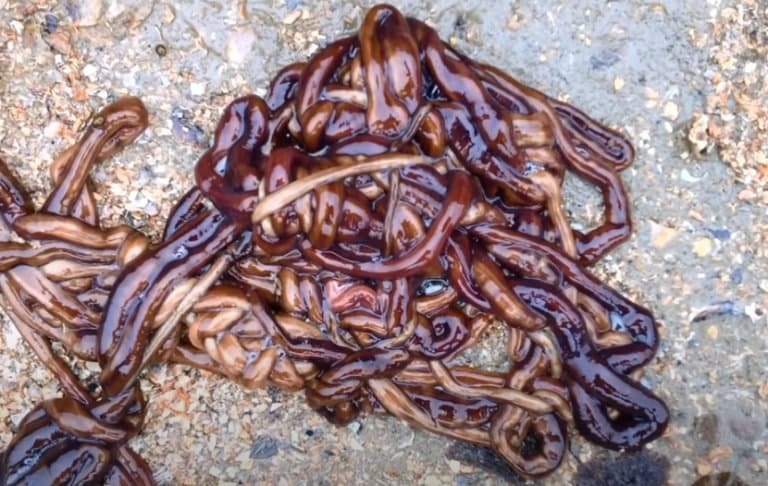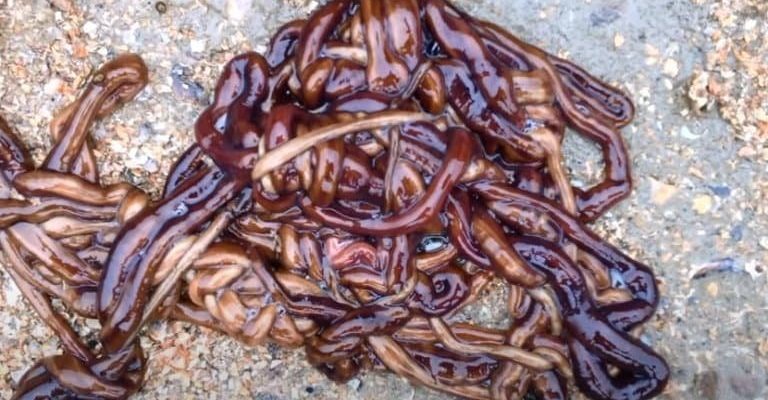
Bootlace worms, belonging to the genus *Lineus*, are fascinating creatures that thrive in the intertidal zones. They can be found hiding among rocks and seaweed, blending into their environment. If you’ve ever walked along the coast and spotted a long, slimy creature slithering in the water, there’s a good chance it was a bootlace worm. While they might not win any beauty contests, their biology and behavior are worth exploring. Let’s dive deeper into how to identify these unique worms and what makes them so interesting!
What Are Bootlace Worms?
Bootlace worms are part of the ribbon worm family, scientifically known as nemerteans. To put it simply, they’re like the long, colorful cousins of your everyday earthworm, but they inhabit the ocean instead of the soil. They can be incredibly long—some species reach up to 30 meters! Imagine that next time you see one slithering by.
One of the most fascinating aspects of bootlace worms is their *extraordinary flexibility*. They can stretch and contract their bodies, allowing them to weave through rocky crevices and hide from predators. Their bodies are also covered in a slimy mucus that helps keep them moist and allows them to glide through the water effortlessly. Honestly, if you ever see one, it might look a bit like a live piece of spaghetti!
Where Do You Find Bootlace Worms?
You might be wondering where to spot these intriguing creatures. Bootlace worms primarily inhabit **intertidal zones**, specifically in sandy or muddy environments. If you go to a beach during low tide, you have a good chance of encountering them. Look among rocks, seaweed, or even beneath the sand.
Here’s a quick tip: Bootlace worms often come out during the warmer months, so summer and fall are the best times to find them. Their long bodies allow them to burrow into the substrate, so it can sometimes be tricky to spot them at first. But if you’re patient and look closely, you’ll likely see that distinct movement—a hint of a bootlace worm emerging from its hiding spot.
Identifying the Features of Bootlace Worms
So, what exactly should you look for to identify a bootlace worm? Here are the key features:
- Length: Bootlace worms can range from a few centimeters to several meters, making them one of the longest invertebrates.
- Color: They often come in shades of brown, green, or even red. Their coloration can act as camouflage against their rocky or muddy environments.
- Body Structure: Their bodies are long and ribbon-like, which is where they get their name. They might look slimy, and that’s perfectly normal!
When you’ve got your eyes peeled for these features, spotting a bootlace worm becomes much easier. You’ll know you’ve found one when you see a long, slimy creature making its way through the water or sand.
Behavior of Bootlace Worms
Understanding how bootlace worms behave can also help you identify them. These creatures are mostly *burrowers*, meaning they prefer to stay hidden in the sand or among rocks. You’ll often see them extending a portion of their body as they explore their surroundings, searching for food.
One unique behavior of bootlace worms is their *defense mechanism*. If they feel threatened, they can break off a part of their body to escape, regenerating it later. This ability is fascinating and speaks to their resilience in challenging environments. So, if you see one that looks a bit shorter than you’d expect, it might have just gone through a dramatic escape!
Why Bootlace Worms Matter
You might be asking yourself why it’s essential to learn about bootlace worms. Well, these creatures play a crucial role in their ecosystem. They help control the population of smaller organisms in the intertidal zones. Their feeding habits contribute to the balance of the marine food web, impacting everything from tiny plankton to larger fish.
Moreover, studying bootlace worms can provide insights into marine biology and ecology, especially concerning habitat conservation. By understanding these creatures, scientists can make better decisions to protect their habitats and ensure that these fascinating beings continue to thrive.
Common Misconceptions
There are some common misconceptions about bootlace worms that are worth addressing. For instance, people often mistake them for harmful creatures because of their slimy appearance. However, bootlace worms are not dangerous to humans. They primarily feed on smaller organisms like snails and other invertebrates, posing no threat to beachgoers.
Another misconception is that all ribbon worms are bootlace worms. While many ribbon worms exhibit similar characteristics, not all of them belong to the *Lineus* genus. It’s essential to recognize the differences between species when identifying these incredible worms.
How to Observe Bootlace Worms Responsibly
If you’re eager to observe bootlace worms, it’s crucial to do so responsibly. Here are some tips to keep in mind:
- Don’t disturb their habitat: When exploring intertidal zones, be mindful of not disrupting the sand or rocks where these worms live.
- Use gentle techniques: If you want to interact with a bootlace worm, do so delicately. Avoid grabbing or pulling on their bodies, as it can harm them.
- Educate others: Share your knowledge about bootlace worms with friends and family. The more people know about them, the better chance these creatures have at being respected and protected.
Being a responsible observer helps ensure that these unique creatures continue to thrive in their habitats for generations to come.
In Conclusion
Bootlace worms are truly fascinating creatures, and their presence in intertidal zones adds an exciting element to our understanding of marine life. By learning to identify and appreciate them, we can foster a deeper connection to the ocean ecosystem. Whether you’re a beachcomber or an avid marine enthusiast, keeping an eye out for these long, squiggly worms can enrich your coastal experiences.
So next time you’re at the beach, take a moment to look beyond the usual suspects. You never know what amazing creatures like the bootlace worm are waiting to be discovered!

